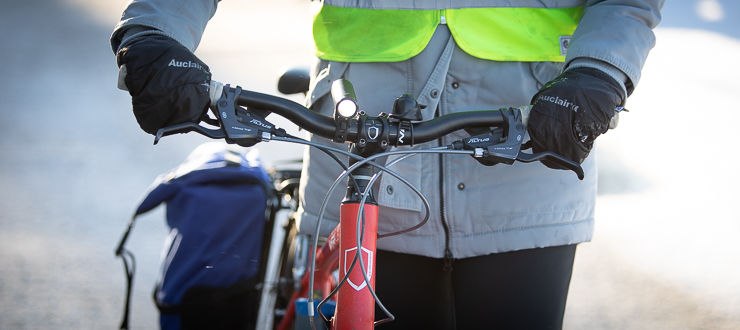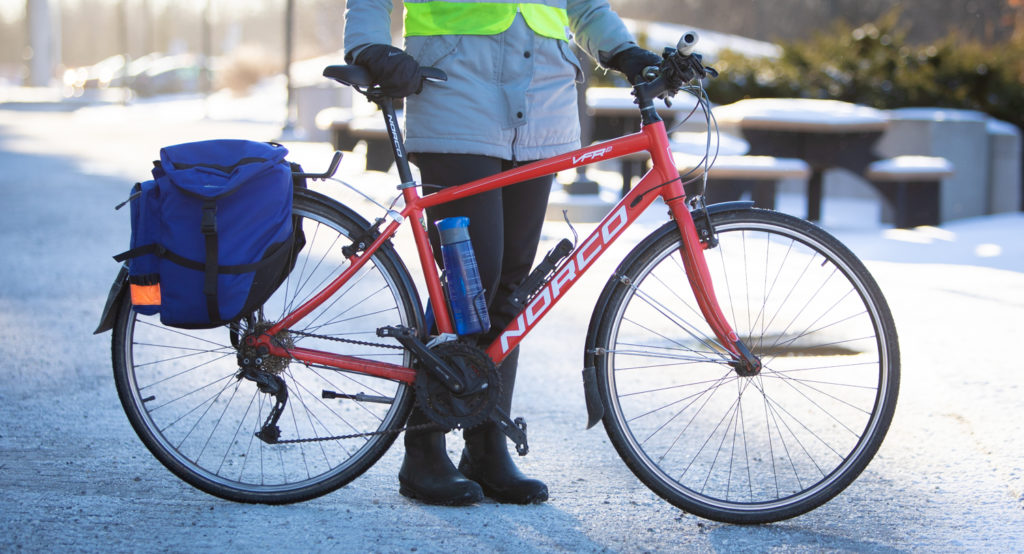
During his early days in the notoriously cold and snowy city of Ottawa, Dr. Mark Walker was always baffled whenever he saw a cyclist on the road in the middle of winter. From the warmth of his car, he would wonder, “Why would anyone do that?”
Today, he is an avid all-season bike commuter himself.
“I now actively encourage people to try to stay on two wheels all year long,” says Dr. Walker. “Cycling has an array of health benefits, for you and the planet.”
Dr. Walker is a member of a growing coalition of health-care providers at The Ottawa Hospital who are passionate about cycling year round. Like Dr. Walker, fellow member Dr. Eugenie Waters was at first hesitant about the idea of biking in winter. Now, she bikes to work three days a week no matter the season.
“Biking to work in the middle of winter isn’t as intimidating as it may sound,” she says. “I used to bike just in the fair-weather months, but after talking to some experienced year-round cyclists and listening to their advice, I realized I didn’t have to let winter stop me.”
It’s understandable that you may be concerned about safety, staying warm and the effect on your commute time. This short guide, with tips from The Ottawa Hospital’s physician cyclists, will help you navigate these concerns so you can stay on two wheels all year long.
Why should I bike to work in winter?

Active transportation–meaning any form of human-powered transportation–is healthy for the body and mind.
“Cycling in particular has been shown to prevent many chronic diseases, reduce all-cause mortality and improve mental health,” says Dr. Walker.
Dr. Eugenie Waters has experienced the benefits personally. “It’s been so positive for my own mental health,” she says. “The thing about biking compared to being in your car is it’s very social. On my route, I get to see other cyclists and people out walking or running. That would never happen if I was taking my car every day. I also really enjoy the chance to be outdoors in nature–I’m lucky that part of my route takes me along the Rideau River.”
As an added bonus, active transportation plays an important role in mitigating the effects of climate change. According to the Government of Canada, transportation is the second largest source of greenhouse gas emissions nationally, accounting for 25% of total emissions, with passenger vehicles accounting for approximately half of all transportation-related emissions.
What should I wear?

“You just need the same type of gear that you would wear for any other winter sport,” says Dr. Waters. “Just dress like you’re skiing or skating on the canal.”
Before she sets out on her morning commute, Dr. Waters puts on a balaclava to protect her face from Ottawa’s biting windchill as well as tall winter boots with wool socks. When commuting home at night, she wears a reflective vest to make her stand out on the road. Other than those few specific items, she wears what she usually wears for a winter day: a winter jacket, gloves and a scarf.
If you overdress, you risk overheating. “You warm up really quickly,” says Dr. Waters. “Often, by the time I get close to the hospital, I’m unzipping my coat and opening up my sweater because I’m really warmed up!”
What kind of bike do I need?
You may want to save that luxury bike for spring. For winter, the cycling community at EnviroCentre recommends an old or used bike that you don’t mind exposing to the elements—particularly salt, which can cause rust.
Here are a few other quick tips and considerations courtesy of Ottawa’s EnviroCentre:
- Use a mountain, hybrid or commuter style bike to get the most traction.
- Lower the air pressure in your tires to get a better grip on the road, but don’t go below the manufacturer’s recommended range.
- For traction in snow, thick-tread mountain bike tires are a good option, but for lightly packed snow or slush, thin tires can be very effective for cutting through the snow to reach the pavement.
- For extra traction, consider investing in studded tires.
- Use full fenders to protect yourself from splash-ups.
- Apply wet-weather lubricant to your drive train early in the winter season.
How do I get started?
Everyone has a different path (and that’s our one pun for this article!). For Dr. Waters, she started with taking a few recreational rides around her neighbourhood just to get comfortable. When she was ready to try commuting to work, she started on the nice days when the roads were clear.
“If you’re just getting into it, definitely start on the nice days, even just once a week,” she says. “You don’t have to commit to doing it every day right off the bat.”
How do I plan my route?
A well-planned route can make your commute time comparable to driving. In the fair-weather months, Dr. Waters’ door-to-door commute is only five minutes longer on her bike compared to driving. In winter, she gives herself an extra five-minute head start.
But the best route will always be the safest route. Check out this winter cycling map from Bike Ottawa to see which routes are currently plowed.

Hopes for the future of cycling in Ottawa
“Ottawa has seen a lot of improvements in cycling infrastructure over the last few years, but progress still needs to be made,” says Dr. Waters. “For example, to make more people comfortable and safe biking in winter, we need more segregated bike lanes to separate cyclists from motor vehicle traffic, and they need to be maintained year round.”
Dr. Walker also wants to see greater investment in cycling infrastructure. “Programs to incentivize cycling benefit us all,” he says. “An investment in cycling is an investment in the health of our community.”
More tips to help you get started
If you’re interested in extending your cycling season, The Ottawa Hospital’s year-round cyclists recommend EnviroCentre’s guide to winter cycling.

Support patient care and research at
The Ottawa Hospital
You might also like…
Bringing communities together, one stitch at a time
In celebration of June being both National Indigenous History Month and Pride Month, The Ottawa Hospital hosted a beading workshop for Indigenous and 2SLGBTQIA+ staff and their allies.
Aging well: Guidance for older adults
In this special video series for both older adults and their loved ones, geriatric care specialists from The Ottawa Hospital offer guidance on navigating common health-care challenges that may arise with aging.
How to stay safe around water this summer
Drowning can happen to anyone — even strong swimmers. Emergency physician Dr. Christian Vaillancourt debunks common myths about drowning, explains how to act quickly to save a life, and shares what you can do to keep yourself and your loved ones safe around water.
What’s the difference between an optician, optometrist, orthoptist and ophthalmologist?
“Do I need to see an optician, optometrist, orthoptist or ophthalmologist?” We asked Ophthalmologist Dr. Annick Fournier to break down each role so you will know who to consult for your specific eye care needs.
Understanding rabies: Risks, vaccination and what to do after a bite
Although rare in Canada, rabies is almost always fatal once symptoms appear. Infectious diseases expert Dr. Michaeline McGuinty shares how rabies is spread, when to get vaccinated and what to do after a bite.
“My story doesn’t have to be your story”: New screening test better at preventing cervical cancer
“I went from being a 32-year-old new mom to a cancer patient with an incurable diagnosis.” Alicia’s journey underscores the critical role of HPV testing in preventing cervical cancer. Discover how the new HPV test can save lives and find out how to book your cervical screening appointment with our “Superscreener.”


 To reset, hold the Ctrl key, then press 0.
To reset, hold the Ctrl key, then press 0.





